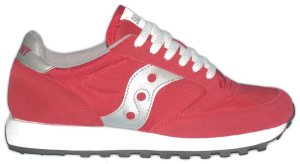
CAUTION: Investments in the stock market can and do lose money; they can also provide significant dividend income and rewarding increases in share value. The companies I list here manufacture athletic shoes, a product whose sales are relatively unpredictable and subject to the whims of consumer demand. Past performance is no guarantee of future performance. This data is historical... using historical information is akin to running backwards (it can be a good exercise but be very careful about running into the unexpected). Potential investors should examine all available data about a given stock, including but not limited to Securities and Exchange Commission filings, before investing.
For those who have asked, I Just Did It: bought about $1000 of adidas Group (made enough to buy almost any pair of sneakers they sell) and about $1000 of Nike (made enough to buy five pairs of Chucks). On the other hand, but if you want to buy stock to make money: also consider Airbus Group, Boeing, or Dr Pepper Snapple Group.
There are a number of athletic shoe companies (as indicated by their Standard Industrial Codes) that are represented in the various stock markets in the United States (NASDAQ, NYSE, or the "over the counter" market).

![]() K-Swiss, Inc. went up 42.2% in 2001, improving on a good performance in 2000.
K-Swiss, Inc. went up 42.2% in 2001, improving on a good performance in 2000.

![]() Nike
investors didn't feel too blue in year of stock price declines; Nike stock went
up 3.7%.
Nike
investors didn't feel too blue in year of stock price declines; Nike stock went
up 3.7%.

![]() Reebok shareholders stayed in the black the past two years... with a 333.9% increase during 2000, followed by a 2.3% increase during 2001. (Reebok is now part of the
adidas Group.)
Reebok shareholders stayed in the black the past two years... with a 333.9% increase during 2000, followed by a 2.3% increase during 2001. (Reebok is now part of the
adidas Group.)

![]() Skechers USA was a stock market darling during much of 2000... it went down less than 1% in 2001. Given the rest of the market in 2001, that might still be a "stock market darling."
Skechers USA was a stock market darling during much of 2000... it went down less than 1% in 2001. Given the rest of the market in 2001, that might still be a "stock market darling."

![]() Stride Rite, maker of Keds and other brands, had a modest 1.9% price decrease.
Stride Rite, maker of Keds and other brands, had a modest 1.9% price decrease.

![]() The stock of Deckers Outdoor Corporation, makers of the Teva sport sandal, doubled in 2000. However, it went down 15% in calendar year 2001.
The stock of Deckers Outdoor Corporation, makers of the Teva sport sandal, doubled in 2000. However, it went down 15% in calendar year 2001.

![]() VANS stockholders finished in the red, with a 20% loss during the year. (NOTE: VANS was later acquired by VF Corporation, predominantly an apparel maker.)
VANS stockholders finished in the red, with a 20% loss during the year. (NOTE: VANS was later acquired by VF Corporation, predominantly an apparel maker.)

![]() FILA followed its 30.7% decline during 2000 with a 60.1% decline during 2001. The FILA ADR is no longer traded.
FILA followed its 30.7% decline during 2000 with a 60.1% decline during 2001. The FILA ADR is no longer traded.

![]() Saucony, Inc. was the big winner in 1998 as well as 1999. However, Saucony Class A stock has slowed down considerably... losing 37.4% during 2001, following a 45.8% loss during 2000. NOTE: Historical interest only; Saucony is now a division of Stride Rite.
Saucony, Inc. was the big winner in 1998 as well as 1999. However, Saucony Class A stock has slowed down considerably... losing 37.4% during 2001, following a 45.8% loss during 2000. NOTE: Historical interest only; Saucony is now a division of Stride Rite.

![]() In April 2001, after bankruptcy, most assets and the rights to the "Converse" brand name were sold to a new owner. At that time, the publicly traded company changed its name to "CVEO Corporation." CVEO Corporation liquidated their remaining assets, and the stock became worthless in August 2002. In December 2002, the new owners of the new, improved, and apparently more solvent Converse proposed an initial public offering... but Nike snapped them up first.
In April 2001, after bankruptcy, most assets and the rights to the "Converse" brand name were sold to a new owner. At that time, the publicly traded company changed its name to "CVEO Corporation." CVEO Corporation liquidated their remaining assets, and the stock became worthless in August 2002. In December 2002, the new owners of the new, improved, and apparently more solvent Converse proposed an initial public offering... but Nike snapped them up first.
![]() Continue onward to
2002's results...
Continue onward to
2002's results...
![]() Back to the top of "Charlie's Sneaker Pages!"
Back to the top of "Charlie's Sneaker Pages!"
Last Updated: 9 December 2018
Click here to send E-mail to Charlie.
Charlie's Sneaker Pages copyright 1995-2024 by Charles L. Perrin.
READERS PLEASE NOTE: Names of athletic shoe manufacturers, shoe styles, and technologies may be trademarked by the manufacturers. Charlie's Sneaker Pages uses these names solely to describe the shoes with the same familiar nomenclature used by the manufacturer and recognized by the reader.